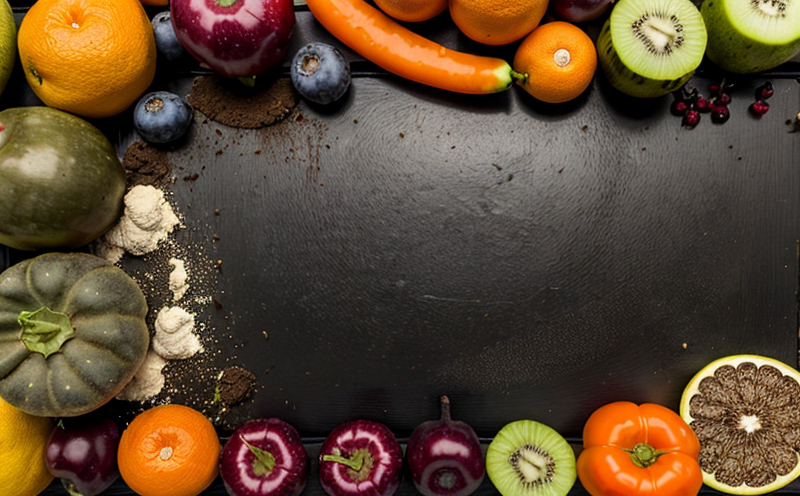ISO 28582 Pesticide Residue Testing in Fresh Fruits
The ISO standard ISO 28582 provides a comprehensive approach to the determination of pesticide residues in fresh fruits. This service is crucial for ensuring that food products meet regulatory and consumer safety standards, particularly in sectors like agriculture, food processing, and retail.
The process begins with the selection of appropriate sampling procedures from ISO 28582, which ensures a representative sample of the fruit being tested. Pre-treatment steps are essential to remove any interfering substances such as waxes or other residues that could affect the accuracy of the test results. The selected pesticides and fungicides must be identified first using methods like liquid chromatography coupled with tandem mass spectrometry (LC-MS/MS), ensuring precision down to parts per billion levels.
Post-treatment, the samples are analyzed according to ISO 28582 guidelines which specify the use of validated analytical techniques. The laboratory employs advanced instrumentation including gas chromatography and high-performance liquid chromatography systems equipped with mass spectrometers for quantification. Compliance with international standards ensures that results are reliable across different laboratories.
The testing process also includes thorough documentation, recording all aspects from initial sampling through final analysis. This detailed record-keeping is vital not just for compliance but also to trace the source of any issues if discrepancies arise later on. Once the data has been compiled and verified, it's reported back to clients alongside recommendations where necessary.
Understanding pesticide residue levels in fresh fruits isn't just about meeting regulatory requirements; it plays a key role in protecting public health by ensuring that no harmful chemicals exceed safe limits set forth by agencies worldwide. By adhering strictly to ISO 28582, we contribute significantly towards maintaining trust among consumers regarding the safety of their food choices.
Our commitment extends beyond compliance; we aim to provide actionable insights that help our clients improve product quality and maintain sustainable practices throughout the supply chain. With rigorous testing protocols and cutting-edge technology at our disposal, ISO 28582 pesticide residue testing offers a robust solution for maintaining high standards of food safety.
Environmental and Sustainability Contributions
Incorporating ISO 28582 into your quality management system can yield significant environmental benefits. By accurately measuring pesticide residues, you contribute to reducing unnecessary overuse of chemicals that could otherwise contaminate soil and water resources. This aligns with broader sustainability goals such as minimizing ecological footprint and promoting responsible agricultural practices.
The precise identification and quantification enabled by ISO 28582 helps farmers make informed decisions about pesticide application rates, thereby optimizing resource use efficiency without compromising yield or quality. Over time, this can lead to reduced waste generation associated with unused chemicals, lower emissions from transportation of these substances, and decreased risk of accidental spills during handling.
Moreover, compliance with ISO 28582 fosters transparency within supply chains, enabling all stakeholders involved—from growers to retailers—to track the journey of products more effectively. This enhanced traceability supports efforts aimed at improving overall environmental performance across various stages of production and distribution.
By integrating our services into your operations, you not only meet regulatory expectations but also demonstrate leadership in promoting sustainability. Through rigorous testing and robust reporting mechanisms provided by ISO 28582, you can ensure that every step taken towards food safety contributes positively to global environmental health.
Competitive Advantage and Market Impact
Adhering to the stringent requirements outlined in ISO 28582 offers several competitive advantages that can significantly impact your business. One major benefit is enhanced consumer confidence, which translates directly into greater market share and loyal customer bases. Consumers are increasingly concerned about what they eat and how it affects their health; by demonstrating compliance with international standards like ISO 28582, you position yourself as a leader in food safety.
Another advantage lies in regulatory compliance, ensuring that your products meet all necessary legal requirements without fear of recalls or fines. This not only protects your brand reputation but also saves time and money associated with potential legal actions. Furthermore, adherence to these standards can open up new markets both domestically and internationally where stringent regulations apply.
From a competitive standpoint, ISO 28582 compliance sets you apart from competitors who may not prioritize food safety as rigorously. It signals commitment to excellence in quality assurance processes, which is increasingly becoming an important factor for buyers when selecting suppliers. In today’s competitive market environment, being able to prove your dedication to maintaining the highest standards of food safety can be a decisive factor.
Lastly, by investing in ISO 28582 pesticide residue testing services, you demonstrate responsibility towards society and the planet. This aligns with growing consumer demand for sustainable products, making it easier for your company to connect emotionally with potential customers who value these values highly.
Use Cases and Application Examples
| Use Case/Application Example | Description |
|---|---|
| Grower Quality Assurance | Monitoring pesticide residues during crop growth to ensure compliance with regulatory limits. |
| Packager Compliance Verification | Verifying that processed fruits meet required residue levels before packaging for shipment. |
| Retailer Safety Checks | Performing spot checks at retail locations to confirm adherence to safety protocols throughout the supply chain. |
| Distributor Quality Control | Ensuring incoming shipments comply with established criteria, preventing contaminated products from reaching consumers. |
| Export Certification | Providing documentation needed for export markets that have stricter regulations regarding pesticide use. |
| R&D Innovation Support | Assisting researchers in developing safer formulations by identifying effective yet compliant pesticides. |
The above examples illustrate how ISO 28582 plays a crucial role across different stages of the fruit supply chain. From farm to table, every step involves careful monitoring and verification using this standard as a guide.





